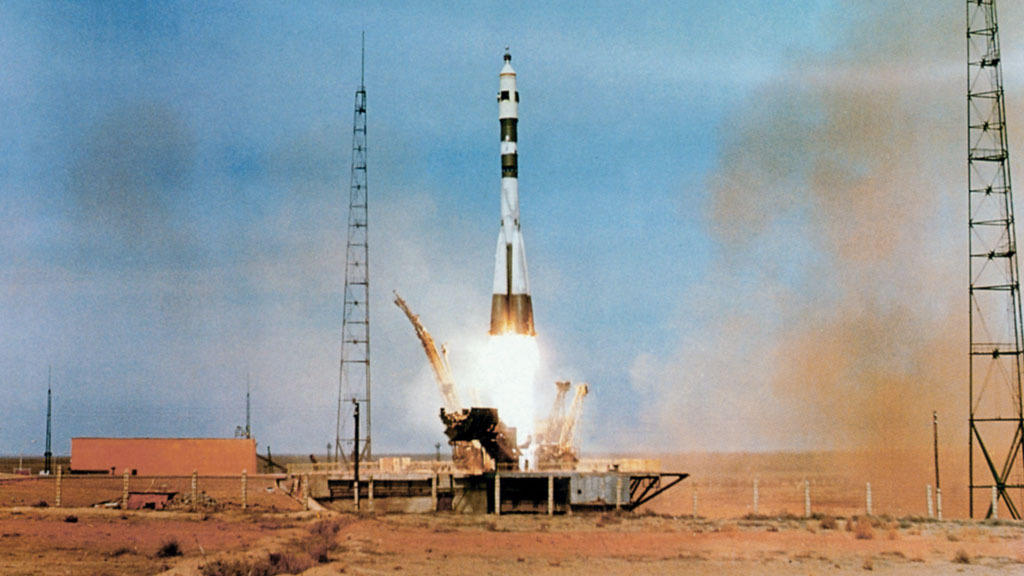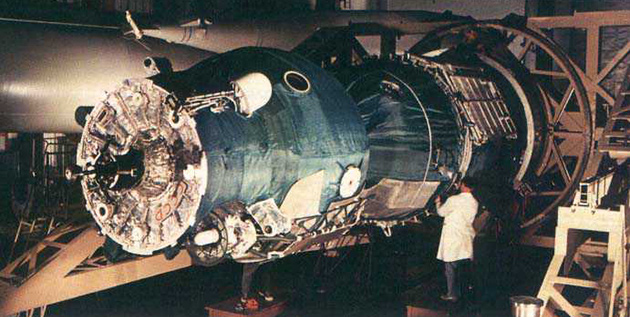The paralells between the American and Soviet space programs in 1967 to 1968 are quite strange. On January 27th 1967 America had the Apollo 1 Fire which resulted in the delay of the first manned flight of Apollo until October 1968 and the Apollo 7 Mission.
The Soviet Union had a similarly bad situation with the first manned flight of their new Soyuz spacecraft on April 23rd, 1967 – Soyuz 1 had problems almost immediately following launch and, despite the odds being against the pilot, Vladimir Komarov, to even being able to bring the craft back to Earth, he did successuflly complete re-entry… only to have the parachute system fail and the descent module crash to the ground, killing him and putting a similar stop on Soviet space flight.
Move to October 1968 – the United States launches Apollo 7 on October 11th, successfully returning to manned space flight and beginning a spectacular series of flights which result in humans reaching the moon just 9 months later.
The Soviet Union was making equal progress on their program – Soyuz was designed in part to work as the base for their upcoming lunar program which was in and of itself starting to come together – Their Zond 5 spacecraft, based on the design of Soyuz, had successfully went around the Moon and returned to Earth, carrying some animals with it, and their massive N-1 moon rocket was poised at the launch pads ready for its first test flight. There was only one thing missing from their program – an active crewed program.
On October 26th, 1968 the Soviet Union made their return to manned flight with the launch of Soyuz 3. Much like Apollo 7 this flight was intended to test the changes made to Soyuz but unlike Apollo 7 had additional goals. The Russians had never conducted a docking in space before (which was part of the originally planned Soyuz 1 mission) so they were planning this flight to be the one which would demonstrate their ability to conduct such, a requirement for future Moon missions and their still in the works space station program, Salyut.
The launch of Soyuz 3 carried cosmonaut Georgy Beregovoy, at that time the oldest person to fligh into space, into orbit to test the vehicle and attempt docking with Soyuz 2, which had been launched the previous day. Beregovoy was able to navigate to a rendezvous with the unmanned Soyuz 2 vehicle, but issues with the orientation of the target vehicle resulted in an abandonment of the docking attempt, something to be tried on the next set of Soyuz flights.
Of course, the secretive nature of the Soviet Union at this time resulted in them not even acknowleding or announcing the launch of Soyuz 2 until Soyuz 3 was already safely on orbit, and the mission was described only as a rendezvous attempt rather than a docking attempt – a fact which was not acknowledged until many years later after the end of the Soviet Union.
The missions was still, however, treated as a comple success, ending on October 30th with a safe landing of the Soyuz vehicle and its pilot. Following the flight Beregovoy was promoted to Major and awared the title of “Hero of the Soviet Union,” the highest honor a Soviet citizen could be awarded.
This mission would set the stage for a wave of relative success in the Soviet space program, at least with Soyuz and the eventual Salyut program – their lunar program, however, was destined for disaster.
Below are some videos uploaded by Roskosmos regarding the 50th anniversary of this historic flight and the carreer of its pilot. You have to admire the pride that Russians still feel about their space program, which they rightly should – screw politics, their space program is, and has always been, rather amazing.
It’s also interesting to note that photos of the Soyuz booster on the pad were published by the Soviet Union at the time of the mission, and were the first time the western world would see an R-7 based rocket.
https://en.wikipedia.org/wiki/Soyuz_3


